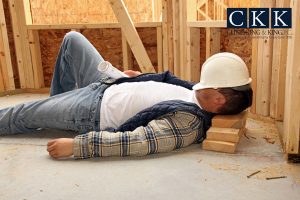 Spring, along with park visits and soccer games, will return soon. The season will bring the worry parents have about sports safety and playground equipment safety, but there’s an even more concerning safety issues you may not even be aware of. It’s the ground children play on: synthetic turf.
Spring, along with park visits and soccer games, will return soon. The season will bring the worry parents have about sports safety and playground equipment safety, but there’s an even more concerning safety issues you may not even be aware of. It’s the ground children play on: synthetic turf.
Made from crumb rubber, rubber primarily from recycled tires, synthetic fields contain chemicals, metals, and carcinogens. Manufacturers currently say their fields are safe, the levels of these metals and chemicals are minimal and at safe levels, not posing threats to humans. With more than 11,000 synthetic fields across the country at schools and parks, in addition to many playgrounds that currently utilize crumb rubber, there is a lot of the rubber out there with little conclusive information on the health hazards they pose.
Synthetic fields and rubber filler for playgrounds were supposed to be a solution for the growing used tire problems. It recycled a product that couldn’t naturally decompose and also provided a cheap, long-wear, easy maintenance options for schools and parks. Now, more than anything, the crumb rubber has raised a lot of questions about its safety for those who play in/on it.
A small handful of studies have been conducted regarding the use of synthetic turfs but the studies have not been large enough to concretely determine if there is a risk to health from them. In an interview with the Huffington Post, EPA spokeswoman Laura Allen stated the current existing studies conducted by local, state, and federal government agencies “were not designed, nor were they sufficient in size or scope, to draw conclusions about the safety of all fields across the nation.” With the growing concerns and the lack of research, in 2016 the EPA started new research on recycled tire crumb used in playing fields.
Outside of the limited and ongoing research, multiple people have been informally tracking cancer diagnosis of athletes who regularly played on synthetic fields. Amy Griffin, former goalkeeper for the US National team, has tracked a correlation between artificial fields and cancer diagnosis in more than 200 athletes. Ethan Zohn, a former professional goalkeeper who was diagnosed with Hodgkin lymphoma, has also tracked more than fifty athletes that once played on synthetic fields who now have cancer. Though the correlation does not equal causation, there are a lot of similarities in their lists that need to be explored further, including the fact that the majority of these athletes have been diagnosed with Lymphoma, outpacing Leukemia, the most common cancer in young adults.
With mounting concerns and lack of research, some school boards and local municipalities have already put a freeze on installation of new crumb fields, with some going as far to remove and replace fields they already had installed. While we wait on new research from the EPA to be completed, we also need to stop and demand more from the manufacturers. The questions now being posed, the concerns about health related safety of the fields, should have been addressed with thorough hazard and risks analysis before being released as a product option. Their product engineers are the first line to consumer safety.
What do you think? Are you concerned with the hazards of crumb rubber? Let us know on Twitter and Facebook.
Additional Reading:
Worries Mount Over Potential Link Between Artificial Turf And Cancer from The Huffington Post
Turf Battle: The Controversy Over Crumb Rubber Playing Fields from CBS Denver
Federal Research on Recycled Tire Crumb Used on Playing Fields from the EPA
 Both early birds and night owls have specific circadian rhythm that affect when they’re sleepy or tired and when they’re energized and ready to work. Back at the turn of the 20th century, people followed these rhythms, sleeping on average 9 hours a day, living and working during regular daylight hours.
Both early birds and night owls have specific circadian rhythm that affect when they’re sleepy or tired and when they’re energized and ready to work. Back at the turn of the 20th century, people followed these rhythms, sleeping on average 9 hours a day, living and working during regular daylight hours.
 Quick, where is your cell phone? A pretty accurate guess for most readers is your cell phone is within arm’s reach, if not in your pocket or your hands. It probably has at least some portion of your attention right now, even as you’re reading this.
Quick, where is your cell phone? A pretty accurate guess for most readers is your cell phone is within arm’s reach, if not in your pocket or your hands. It probably has at least some portion of your attention right now, even as you’re reading this. Spring, along with park visits and soccer games, will return soon. The season will bring the worry parents have about sports safety and playground equipment safety, but there’s an even more concerning safety issues you may not even be aware of. It’s the ground children play on: synthetic turf.
Spring, along with park visits and soccer games, will return soon. The season will bring the worry parents have about sports safety and playground equipment safety, but there’s an even more concerning safety issues you may not even be aware of. It’s the ground children play on: synthetic turf. If you’re playing Santa Claus for kids this year, get informed before you do your shopping. There are toys out there on the naughty list for being unsafe and you don’t want to give them to the children you love.
If you’re playing Santa Claus for kids this year, get informed before you do your shopping. There are toys out there on the naughty list for being unsafe and you don’t want to give them to the children you love. With 24/7 news access, it’s not uncommon for us to become desensitized to what we hear and read about. It’s the mindset of ‘it won’t happen to me’ playing out. But in many cases, like instances of Carbon Monoxide poisoning in homes, we’re wrong. It can and does affect anyone.
With 24/7 news access, it’s not uncommon for us to become desensitized to what we hear and read about. It’s the mindset of ‘it won’t happen to me’ playing out. But in many cases, like instances of Carbon Monoxide poisoning in homes, we’re wrong. It can and does affect anyone. That common backyard toy your kids continue to ask you for is more than just a toy; trampolines are a money pit and injury waiting to happen.
That common backyard toy your kids continue to ask you for is more than just a toy; trampolines are a money pit and injury waiting to happen.